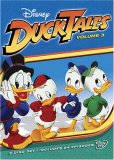Disney Studios reinvented the afternoon cartoon when they introduced something they called Disney Afternoon. It was the brain child of studio animation head Bob Jacquemin. He saw the potential of taking famous Disney cartoons that were already beloved by millions and spinning them off into regular television cartoons. Not willing to take chances with the studio’s icon, Mickey Mouse, Michael Eisner allowed the Donald Duck universe to serve as the launching pad for this new venture. In 1987 Disney Afternoon and Duck Tales was born.
The series centers on Scrooge McDuck and the famous trilogy of duck nephews Huey, Dewey, and Louie. He takes them in while Donald is off in the Navy. He tries to teach them business and responsibility with an eye toward turning his corporation over to them one day. Darkwing Duck’s future sidekick Launchpad McQwack, the bumbling pilot, started life here working for Uncle Scrooge. Gyro Gearloose is an inventor in the Christopher Lloyd Doc Brown mold. Uncle Scrooge is often enlisting his help with one problem or another. Mrs. Beakly serves as the nephews’ nanny. Magica is a common villain in the series as she constantly schemes to get at Uncle Scrooge’s empire. All of this takes place in the town of
This volume includes some rather nice moments in Disney Duck Lore. In Duck To The Future Uncle Scrooge is sent by Magica to the future where he is stranded while she takes over his empire. Uncle Scrooge finds out how his culture of greed affects the kind of ducks the nephews become. Dime Enough For Luck finds Magica again trying to steal Uncle Scrooge’s lucky dime, and his fortune. Donald Duck himself turns up from time to time. In All Ducks On Deck the nephews try to earn Donald a promotion which, of course, backfires. Jack The Ripper encounters the nephews in Dr. Jekyll and Mr. McDuck. Donald is accused of treason in Spies In Their Eyes. There are many more golden moments to enjoy in each 22 minute episode.
Video
Each episode of Duck Tales is presented in its original full frame broadcast format. These episodes are in far better condition than the Tailspin episodes I watched at around the same time. There appears to be less compression artifact, but it is still there. Colors are much brighter, and contrast holds up the image in fine shape. The picture is all around far sharper. I still would like to see less episodes and a better compression rate, as there is no question that when the picture does get fuzzy, as it still too often does, compression is the culprit.
Audio
The Dolby Digital 2.0 track lives almost entirely in the mid ranges. As with the Tailspin episodes dialog is really all you need, so it comes out fine. Some of the music has a near distortion grate to it that I found worked better by reducing the highs. Again, I suspect this will sound pretty much like the broadcast versions.
Special Features
Final Thoughts





